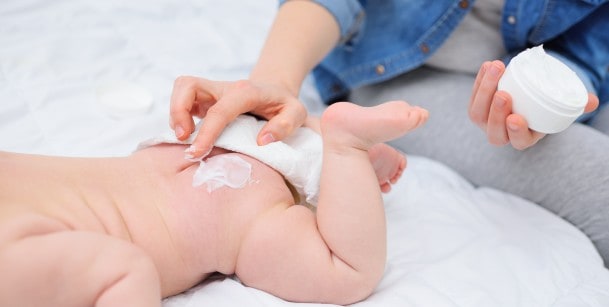Diaper rash and fever is unpleasant for babies and parents alike! The good news is diaper rash is rarely serious, and preventing it from occurring can be simple. In this article, we will go over everything you need to know about avoiding diaper rash and fever, as well as what you can do to treat diaper rash at home.
What is Diaper Rash?
Diaper rash is red, tender-looking patches of skin that appear on a baby’s bottom or genital area. This irritated skin can be present in just a few spots or all over the diaper area. This rash will make your baby’s skin sensitive to the touch, and this mild pain may result in crying when the area is touched or cleaned.
While this ailment is very common in babies, most of the time, it is not very serious and can be easily treated at home. However, some cases of diaper rash can become more serious.
More severe cases of diaper rash may involve pimples, blisters, or sores, and an infection of the aggravated area may give the skin a bright red, inflamed, and swollen appearance. The surface area of the rash may expand, and in some severe cases of diaper rash, blood may appear in your baby’s stool. In these rare cases, symptoms will persist and potentially get worse despite consistent at-home treatment.
How Often Does Diaper Rash Occur
Diaper rash occurs most often in infants from birth until about three years of age or as long as the child is in diapers. While this rash is commonly associated with babies, it can become an issue for anyone wearing a diaper regularly.
Most parents will need to treat diaper rash once every two months, most frequently when their child is between nine to twelve months of age. Normally, diaper rash will resolve in three to four days with the proper treatment.
Causes of Diaper Rash
Most commonly, diaper rash is caused by a bacterial infection. When not taken care of properly, a baby’s diaper can create the perfect environment for said bacteria to grow. However, there are also other potential causes of diaper rash. Keep reading to learn more about the potential causes of diaper rash.
Moisture from Feces or Urine
When a baby is left in a wet or dirty diaper for too long, there is a good chance that diaper rash will develop. The moisture and waste create a breeding ground for irritating bacteria. Frequent bowel movements or diarrhea can also irritate the skin.
Skin Irritation
Diaper rash can also be caused by consistent friction on tender skin. When diapers rub against the skin or are fastened too tightly, they can cause irritation.
Yeast Infection
Yeast infections can also cause diaper rash. A fungus called candida is naturally present on the human body, and it grows best in warm, moist places; when the fungus grows out of control, it causes a yeast infection. The resulting rash is normally bright red, with small red spots around the edges of the rash. The chance of yeast infections can increase if a baby is taking antibiotics or if the baby’s mother is on antibiotics while breastfeeding.
Allergic Reaction
It may come as no surprise that babies have sensitive skin. When they are exposed to new soaps, laundry detergents, fabric softeners, disposable diapers, diaper wipes, or lotions they will sometimes experience allergic reactions and skin irritation. When trying out new products, be on the lookout for negative skin reactions and stop using products immediately if you suspect that they are causing an allergic reaction.
New Foods
New foods or changes in your baby’s diet can change the content and frequency of their bowel movements. As we stated earlier, more frequent stool or diarrhea can make diaper rash more likely. It is also important to keep in mind that a breastfed baby can also develop a rash in response to food that their mother has eaten.
Underlying Skin Condition or External Factors
Sometimes, diaper rash can be caused by underlying skin conditions, such as psoriasis, or exposure to external irritants like scabies or fleas. A doctor will be able to determine whether or not your child has an underlying skin condition, and carefully monitoring your child’s environment may help prevent exposure to insect bites or other irritants.
Symptoms of Diaper Rash
Symptoms of diaper rash can range from mild to severe. Mild rashes involve pink, dry skin that is itchy and tender without being outright painful for your baby. However, they may experience mild discomfort and fuss or cry during diaper changes.
Severe rashes have areas of bright red skin and other blemishes and may be painful. In some cases, the skin may even become raw or begin bleeding. Your child may cry frequently and experience trouble sleeping due to their discomfort.
It is important to note that diaper rash may cause changes in skin color for babies with darker complections. This is a temporary condition called post-inflammatory hypopigmentation. This change will normally clear on its own in a few weeks, but more severe cases may take months or years.
Does Diaper Rash Cause Fever?
Do diaper rash and fever go hand in hand? They certainly can! If your baby has a severe bacterial infection they can develop a fever as one of their symptoms.

How to Treat Diaper Rash at Home
Luckily, diaper rash treatments are easy to do at home! All you have to do is follow your ABCs! Specifically, A, B, C, D, and E.
A – Air Out
The best way to beat diaper rash is by making sure the affected area is kept as clean and dry as possible. You can air dry your child’s bottom by letting them go diaper-free and placing a waterproof barrier underneath them to minimize messes. Additionally, when you put the diaper on your baby, make sure that there is no tape attached directly to their skin and that the diaper is fastened loosely to allow airflow.
B – Barrier
When trying to get rid of diaper rash, it is important to avoid further irritating the skin. You can use skin creams to create a barrier between your baby’s skin and other irritants. Said diaper cream should be applied at every diaper change and can be covered with a thin layer of Vaseline or petroleum jelly to prevent it from sticking to the diaper.
C – Clean
It’s very important to keep your baby’s skin as clean and bacteria-free as possible during the healing phase to reduce the possible risk of infection. Clean your baby gently with fragrance-free, mild soap and lukewarm water, and then pat them dry or allow them to air dry. Do not rub the skin dry, as this can cause further irritation. Make sure to wash your hands frequently, as this can also help reduce your baby’s risk of infection.
D – Disposable Diapers
Whether you prefer using cloth diapers or disposable diapers, using disposable diapers during your baby’s diaper rash will make it easier to keep up with frequent diaper changes. Prompt diaper changes reduce the time your baby will sit in wet, decreasing the chance of further infection or irritation.
E – Education on Prevention
The best way to treat and prevent diaper rash is to learn the causes, signs, and popular prevention methods! That means you’re in the right place.
When to Seek Medical Attention
While most cases of diaper rash are not serious, it’s important to know when to reach out for professional medical help. Call your doctor if:
- You notice pimples or small sores forming on your baby’s skin.
- The diaper rash begins to bleed, ooze pus, or weep.
- Your baby has a fever of 100.4 °F or higher.
- The rash spreads to other areas, including the arms, face, or scalp.
- Your baby’s skin begins peeling off in sheets
- The rash gets worse despite at-home treatment.
- The rash is extremely painful, as this may be a sign of cellulitis.
- The diaper rash occurs in the first 6 weeks of life.
Most importantly, you should simply reach out to your doctor if you want to. Being sure is priceless when it comes to your child’s health, and your pediatrician won’t mind a check-up to make sure that your case of diaper rash is normal and manageable.

How to Avoid Diaper Rash and Fever
The best way to prevent diaper rash is to make sure your baby’s bottom and genital area stay as cool, clean, and dry as possible! You can do this by:
- Checking your baby’s diaper frequently and changing it if it is soiled.
- Allowing your baby’s skin to dry before putting on a new diaper.
- Fitting diapers loosely to allow airflow.
- Washing your hands before and after changing diapers to cut down on bacteria.
Get Help From Your Village!
If your baby is suffering from a bad case of diaper rash, reach out to your Village! Our physicians are proud to offer comprehensive pediatric care at all of our facilities. Visit our website to learn more and find your Village today!
